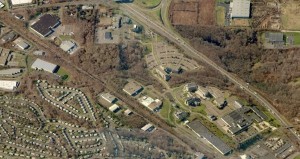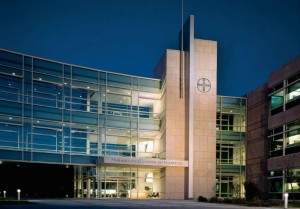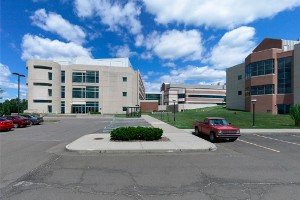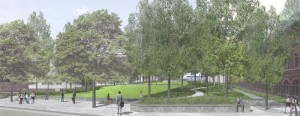Science at Yale, in the physical form if not always in the academic, has always existed on the fringe of campus life. In the nineteenth century, Yale consciously denied chemistry laboratories space on Old Campus. The early twentieth century saw the development of Science Hill, even farther away from central campus. In 2007, the long tradition of sending the Sciences to the fringe of campus continued with the purchase of the 136-acre West Campus in West Haven. Science Hill, meanwhile, has begun what will be a long transformation into a new center of student life.
The acquisition of West Campus, built originally as the headquarters of Bayer Pharmaceuticals, is similar to the large land purchase of Science Hill north of Yale’s central campus in 1910. Unlike the wooded Science Hill, the West Campus came with state-of-the art equipment and lab space. Yet the existing architecture of West Campus could not be further from that on the campus in New Haven. In the mile between Phelps Gate and the Divinity school, Yale has constructed a tight, urban landscape of quads in a number of architectural styles, but almost always with great attention to design and built by high-profile Yale architects.

In the mile between the two West Campus guardhouses, office buildings and massive warehouses sit amid forests and parking lots alongside Interstate 95 (Figure 1). The corporate architecture firm Flad Architects designed Bayer’s Administration Building, which sits at the center of the sprawling, suburban West Campus (Figure 2). The Administration Building is a steel and glass corporate box with two wings surrounding an open and uninviting courtyard, vastly out of scale with the pedestrian user.
While it is the most architecturally interesting building on site, the central Administration building is more mundane than anything Yale has constructed in New Haven — even less exciting than the much maligned Swing Space dormitory. Architecture professor Kent Bloomer notes that “there is something Frankenstein-like about [Yale’s] old science buildings, like Sterling Hall of Medicine. They loom dark and heavy, as if some mad scientist was working away inside,” while West Campus “has nothing to say that science, let alone that Yale, is here.”
What the new campus lacks in character it makes up for in potential. A lack of space and the cost of constructing new buildings can prevent institutional expansion but the scale of West Campus is so vast that opportunities for growth abound (Figure 3). Woodbridge Hall, Yale’s administration building in New Haven that contains the office of President Levin, has about 8,000 square feet of usable space, whereas the Administration Building at West Campus has 250,000 square feet ready for any type of clerical work. The parking lot for the building radiates out in concentric arcs, and this parking lot alone is twice the size of Old Campus.

Before the focus shifts to the West Campus, though, there is still great work to be done on Science Hill itself. In the coming years, the area will become much to the active, dense network of the central campus. Landscape architect Laurie Olin has developed a forty-year plan for the site which connects new and old buildings with landscaping to form a series of quadrangles and courtyards (Figure 4).
The first phase of Olin’s plan has already been implemented with the construction of Kroon Hall on Prospect Street.
Designed by Hopkins Architects of Great Britain and Centerbrook Architects of Connecticut, the landmark building for the School of Forestry and Environmental Science has received plenty of press for its environmental sustainability. From a design standpoint, Kroon has introduced the yellow sandstone of Yale’s gothic buildings, like Harkness Tower and Sterling Memorial Library, to Science Hill. Along with Charles Haight’s 1910 Osborn Lab building, Kroon overlooks a courtyard in the traditional Yale manner. Inside, hand-milled woodwork mixes seamlessly with the latest developments in environmental engineering to create a truly remarkable central hall across the top floor of the building. To craft an exciting place is an elusive architectural goal, but it is one pleasantly abundant at Yale and in this new building. Kroon Hall is the antithesis of the sprawling West Campus; it is small and comfortable, without sacrificing efficiency or design innovation.

Kroon marks the begining of a new phase for Science Hill: less focus on increasing lab space and a greater emphasis on bringing student life past Grove Street Cemetery and up the Hill. The recently completed Yale Health building by architects Mack Scogin Merrill Elam, Rosenkranz Hall for the Political Science Department by Koetter and Kim, and the 1958 Ingalls Rink by Eero Saarinen join in drawing a myriad of students closer to Science Hill. Dramatic change will come when two new Residential Colleges designed by Robert Stern, Dean of the School of Architecture, open on Prospect Street above Locke Street. Eventually, a new library or student center will occupy the current home of the School of Management at Prospect and Sachem streets. Dean Stern believes this new building “will be a force to bring students from the other Colleges up Science Hill, regardless of their major. It will likely be a modern building, so the gothic Osborn Labs will face the gothic colleges, and Saarinen’s modern rink will face a new, contemporary structure.” Though far into the future, this eclectic mix of building types and styles will continue the diversity that exists on the central campus. Science Hill as it currently sits, desolate and uninviting, will cease to exist. The tragedy will be if the best of the sciences goes with it.
What, then, can the University do about the West Campus, to keep students engaged with the sciences as research and lab space move farther away from undergraduates – the student population that Yale strives to give its greatest emphasis? While the West Campus will not have the historical richness and diversity of Yale for quite some time, a careful plan of development must be made to ensure West Campus doesn’t forever remain just Bayer Corporation’s old corporate headquarters. Instead, it has the potential to become the twenty-first century chapter of Yale’s great architectural tradition. Is it possible to bridge a seven-mile gap between science facilities? What remains on Science Hill, and what goes west? Is close proximity most important to undergraduate education, or cutting edge facilities? These questions will not be answered for a long time, and the answer will likely not be found by attempting to superficially make the West Campus “like Yale”. As Yale continues to use and repurpose its limited land in downtown New Haven, the West Campus sits as an exciting problem and resource for architects and scientists alike.

